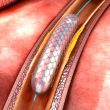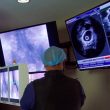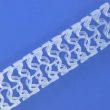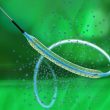Courtesy of Dr. Javier Castro. Certain coronary lesions have been historically discouraged for endovascular treatment. Among these can be found left main coronary artery lesions, multivessel disease, and proximal anterior descending artery lesions. As a matter of fact, the latter is actually considered separately as a criterion for choosing the revascularization method. Endovascular treatment of<a href="https://solaci.org/en/2017/04/20/proximal-anterior-descending-artery-angioplasty-what-are-its-long-term-outcomes/" title="Read more" >...</a>
Why We Should Use IVUS in Complex Coronary Lesions
Courtesy of Dr. Carlos Fava. Drug eluting stents (DES) have shown benefits in terms of restenosis vs. conventional bare metal stents (BMS). Many of the advantages of DES depend on correct implantation, especially in complex lesions. In complex lesions, the use of intravascular ultrasound (IVUS) provides important information on lesion length, vessel diameter, calcification<a href="https://solaci.org/en/2017/03/20/why-we-should-use-ivus-in-complex-coronary-lesions/" title="Read more" >...</a>
DES: Best Option in Saphenous Vein Grafts
These results confirm that, despite being used less and less worldwide, DES (drug eluting stents) are the best option in saphenous vein grafts. Saphenous vein graft atherosclerosis has a different pathophysiology to that of native arteries, and PCI in this context is less effective because of high risk of friable thromboembolic material, faster plaque<a href="https://solaci.org/en/2016/09/07/des-best-option-in-saphenous-vein-grafts/" title="Read more" >...</a>
BVS: Comparable to Second-Generation DES in Complex Lesions
A center carrying out a mid- to long-term follow-up of the performance of everolimus-eluting bioresorbable scaffolds (Absorb) observed that this new device has an acceptable rate of major cardiovascular events, when compared to second-generation drug-eluting stents. Furthermore, although the population was complex and non-selected, no cases of early thrombosis were reported. This study enrolled 249 patients<a href="https://solaci.org/en/2016/08/03/bvs-comparable-to-second-generation-des-in-complex-lesions/" title="Read more" >...</a>
Tissue Protrusion after DES: Adverse Events at Long Term?
Original Title: Tissue Protrusion after Stent Implantation. An ADAPT-DES Intravascular Ultrasound Substudy. Reference: Fuyu Qiu et al. J Am Coll Cardiol Intv. 2016;9(14):1499-1507. After DES implantation we may observe tissue protrusion (plaque or thrombus) relatively often, especially in unstable lesions; however, its clinical impact has not been studied. The aim of this study was<a href="https://solaci.org/en/2016/07/21/tissue-protrusion-after-des-adverse-events-at-long-term/" title="Read more" >...</a>
Drug eluting balloon vs. second generation DES for restenotic lesions in bifurcations
Original Title: Drug-eluting balloon versus second-generation drug-eluting stent for the treatment of restenotic lesions involving coronary bifurcations. Reference: Toru Naganuma et al. EuroIntervention 2016;11:989-995 Courtesy of del Dr. Santiago F. Coroleu. PCI involving in-stent restenosis (ISR), especially in coronary bifurcations, is associated with high rates of recurrent restenosis and the need for new revascularization. Although drug<a href="https://solaci.org/en/2016/02/10/drug-eluting-balloon-vs-second-generation-des-for-restenotic-lesions-in-bifurcations/" title="Read more" >...</a>
Aspirin or Clopidogrel as Monotherapy after 12 month DAPT
Original Title: Clopidogrel versus Aspirin as an Antiplatelet Monotherapy after 12-Month Dual-Antiplatelet Therapy in the Era of Drug-Eluting Stents. Reference: Taek Kyu Park et al. Circ Cardiovasc Interv. 2016 Jan;9(1):e002816. Courtesy of Dr. José Amadeo Guillermo Álvarez. The use of dual antiplatelet therapy (DAPT) over 12 months after hospitalization for acute myocardial infarction (AMI) or drug<a href="https://solaci.org/en/2016/02/04/aspirin-or-clopidogrel-as-monotherapy-after-12-month-dapt/" title="Read more" >...</a>
DAPT TRIAL: double antiaggregation remains controversial
Article This multicenter randomized control study with placebo was designed to determine the risks and benefits of double antiaggregation for longer than 12 months post DES stenting. 9961 patients were randomized to continue on placebo or thienopyridine after 12 months. Thienopyridine reduces the incidence of in-stent thrombosis (0.4% vs 1.4%; p<0,001) and cardiovascular events (4.3%<a href="https://solaci.org/en/2015/06/24/dapt-trial-double-antiaggregation-remains-controversial/" title="Read more" >...</a>
SECURITY: 6 months versus 12 months of dual anti-aggregation using 2nd generation DES
This multicenter noninferiority design work included 1399 patients randomized to receive 6 months (n = 682) versus 1 year (n = 717) dual anti-aggregation after implantation of 2nd generation drug-eluting stent. The primary end point was a composite of cardiac death, myocardial infarction, stroke, definite or probable thrombosis, and major bleeding. At 12 months follow-up<a href="https://solaci.org/en/2015/06/24/security-6-months-versus-12-months-of-dual-anti-aggregation-using-2nd-generation-des/" title="Read more" >...</a>
CTO-IVUS: IVUS clinical impact in total occlusions with 2nd generation DES
While the use of intravascular ultrasound (IVUS) during coronary intervention proved useful in multiple studies, there is limited evidence in the literature regarding its use in specifically in chronic total occlusions. The IVUS may help guide in recognizing the true lumen and better distal positioning, better coverage of stent, an optimal apposition and expansion, diagnose<a href="https://solaci.org/en/2015/06/24/cto-ivus-ivus-clinical-impact-in-total-occlusions-with-2nd-generation-des/" title="Read more" >...</a>









